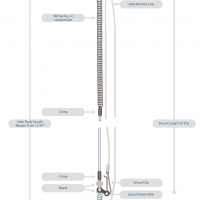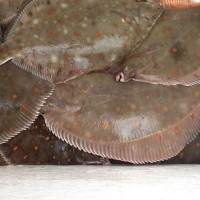What’s the best fishing rig? At fishingtails we are constantly asked to recommend the rigs we use and show how we make them. In this, the first of our rig articles, I want to show you how to make an Up and Over Rig.
The Up and Over Rig is used to target larger fish, such as Cod, Ray and Smoothound, but it is also useful as a distance rig for Plaice. One of the main advantages of the the Up and Over Rig, is it allows you to have a longer snood length that is still streamlined for a distance cast.
I have been using the Up and Over Rig a lot this winter, often in preference to one of my other favourite rig, the Pulley Rig (next rig article). I believe the Up and Over Rig allows you to fish a bait hard on the sea bed, just as you would with a Pulley Rig. The main difference is the amount of fish hooked seems to be considerably higher on the Up and Over compared to others.
I am not exactly certain why this is the case, but my theory is because the fish has a long length of leader to tighten before it hits the resistance of the weight, it isn’t scared off and hooks up. With a pulley rig, however, the fish has a chance to feel increasing resistance as the line runs through the swivel before hitting the stop that is the weight. This could give the fish the opportunity to drop the bait without us even knowing. This is something we hope to prove this year through using underwater camera’s to see how rigs actually work when cast out. Whether the theory is right or complete nonsense, it’s hard to tell without proof, but I do know the rig works.
If the rig is so good, why not use it all the time? Simply because when you are fishing over rough ground or in very rough conditions, you want the weight of the fish to keep the weight in line and not dragging on the bottom. I lost several decent fish in rough surf on Chesil due to the weight on the Up and Over Rig catching on the shingle, just as I was trying to land the fish in the surf.
[image_magnify src=”https://fishingtails.co.uk/wp-content/uploads/2016/01/up-and-over-righires.png” src_big=”https://fishingtails.co.uk/wp-content/uploads/2016/01/up-and-over-righires.png” w=”1024″ h=”2048″ alt=”ALT_TEXT_OF_IMAGE” clas=”CSS_CLASS” /]
Rig components: All of the components, with the exception of the hooks are from Gemini and are included in their Genie Rig building tackle box
I use 70lb line for the main body, but others prefer to use slightly heavier or lighter. For the hook lengths (Snood) I use between 15 and 30lb depending on how heavy the fish are I am targeting and how rough the weather is. The lighter you can go the less chance you have of spooking a fish. However there is no point in hooking a 20lb Cod on 15lb line and losing it when it snaps off when the surf pulls it back.
The length of the main rig body will be roughly half of the length of the snood length. I like to assemble all the components and lock the SRT spring and bent rig clip in place, but leave the crimp above the snood swivel until last. This will allow you to clip the hook into the splashdown clip and hook the line over the bent rig clip at the top. You then tension it up and clamp the crimp nice and tight. This should give you the perfect length. Be careful not to crimp too tight or you may damage the line.
The important components of the rig is the SRT spring and bent rig clip. The rig clip is held in position by a piece of silicone rig tube used as a stop knot. It has a small section of rig tubing above it to give the stop a bit of protection and to act as a buffer. To create a stop knot simply thread on a 3-4mm section of silicon tubing then bring the line through the top part again and this creates a knot that can be moved.
The SRT spring keeps tension in the rig when it is all clipped up and helps throw the line off the bent rig clip when it hits the water. This ensures the line doesn’t get caught up and fishes the snood hard on the bottom.
In the diagram I have shown the snood line tied on to a snood clip. I only do this so I can quickly change pre-made snoods to allow me to use different size or more hooks, such as in a pennel rig, or change the strength of the snood line. If you are not going to do that, then simply tie your snood onto your snood swivel.
If you are not going to use Splashdown clips or weights, you can use a a bait clip instead of a rig clip to attach your weight at the bottom of the rig.

[the-upao]









Can’t wait to try this, was having the same discussion about fish dropping baits on the pulley rig!
Great info Sean :))
sean, for the pulley rig theory working better than up and over ( regarding the lead dragging the seabed), doesn’t hold water unless the total length of the pulley rig (top swivel to lead) is much longer than the equivalent up and over rig.
example, if you have both rigs 2ft long from top swivel to lead then when retrieving under the weight of a fish, the lead on both rigs will be in exactly the same position.
this is because the hook is 4ft from the lead in both cases under the tension of a fish that weighs more than the lead itself.
i.e, no difference at all unless the pulley is considerably longer which when under fish tension will create more distance between the lead and hook and therefore in some cases “lifting ” the lead up with tension off the floor, which all depends on the angle of gradient of the beach.
If you try this at home with the 2 rigs ,you will see this .
As for for the hook up rates, I think your right, I use both rigs and have found more missed bites with the pulley!!! I know other anglers feel the same. your ” longer snood theory” could be the case.
I would love to see a video to try and prove these rig theories, would be revealing and very interesting.
cheers
You have a good point there Simon. Not sure then why the up and over rig has caught in the shingle a few times
looking forward to seeing the vid footage of how they work underwater instead of just theory, just two thoughts;- long 30lb snoods twist up and tangle so i use 50lb to keep things stiffer & beat spiders. though i mostly fish at night.
the top end of the rig i simplify by just having a straight genie bait clip tied in by the eye, there’s no srt spring to absorb the shock but plenty of stretch in the nylon does the job unless using smaller fine wire hooks.
i’ve tied a few lately with the lead running on a propper pulley ‘bead’ between the swivel and the gemini clip to give fish a more gradual take up of tension against the rod tip initially as opposed to the lead being fixed for a bolt rig type effect , early results are inconclusive as i’ve not caught much lately on any rig but im getting the feeling that this is less effective .
We are definitely finding that a fixed lead, has a higher hook up lead, as opposed to a Pulley style rig. Each has a place, but on clean ground we have found the Up and Over better, but a pulley rig is far better on rough ground. You have more chancec of getting your fish in. We will be doing a Pulley rig soon.
hi sean, i was talking about incorperating a ‘pully’, in as much as the lead is on a slider, system into an up and over rig , this rig took a 71/2 lb bass & a 10 lb undulate off the beach lastnight. also nailed a 6lb smalleyed . couldn’t compare to a pulley on the night, as other fish fell to a 2 hook flapper on the other rod
Hi Gordon.
Any chance you can send me a picture of the rig. I wouldn’t mind trying it. send it to sean@fishingtails.co.uk if you can.
Hi Sean, My theory on the Pully rig is it really only works in strong lateral tides, the fact is the large bait pulls the snood length and the see-saw trace body up to the lead, with the aid of a strong current, if a fish takes the bait it act likes a bolt rig the fish lift the lead and is a classic trip lift lead bite indication. If however you don’t have strong lateral currents and especially with a strong surf washing around the pully rig the snood tends to flow up with the surf, and with a normally large bait it ends up wrapping it self around the trace body and weight, you might get away with it in calmer conditions, but like you say the fish don’t feel an resistance, it like a see-saw the fish pick up the bait there is no resistance until they move off then they feel the lead and drop the bait. With the up and over rig the long snood is in direct contact with the weight a bolt rig, the fish picks the bait up and has to lift the weight, more fish will be hooked caught this way.
I am from New Zealand and, in my case, fish mainly clean bottom, sandy, surf beaches. I have been using Clip Down Pulley Rigs for some time and have found them regularly successful. Several of my fishing friends have changed over to my rig and have met with success as well. I am about to make up an Up & Over rig and will be interested to see how it goes. If any of you are prepared to share your rig designs, I would appreciate it as I am always keen to experiment. The main fish caught along our beaches here are Kahawai, Snapper, Trevally & occasional Kingfish. Cheers